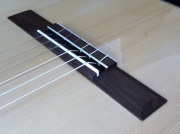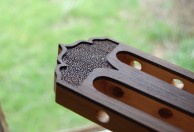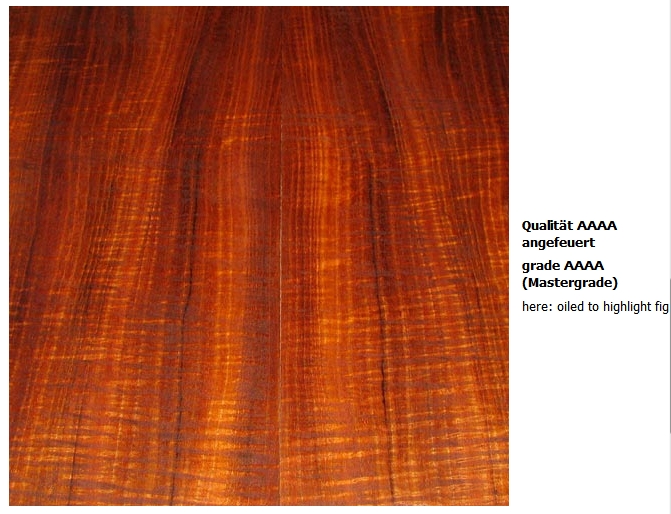Welcome to one of the most active flamenco sites on the Internet. Guests can read most posts but if you want to participate click here to register.
This site is dedicated to the memory of Paco de Lucía, Ron Mitchell, Guy Williams, Linda Elvira, Philip John Lee, Craig Eros, Ben Woods, David Serva and Tom Blackshear who went ahead of us.
We receive 12,200 visitors a month from 200 countries and 1.7 million page impressions a year. To advertise on this site please contact us.
|

|
|
Rough tuning a guitar
|
You are logged in as Guest
|
|
Users viewing this topic: none
|
|
Login  | |
|

   
estebanana
Posts: 9353
Joined: Oct. 16 2009

|
 RE: Rough tuning a guitar (in reply to Vince) RE: Rough tuning a guitar (in reply to Vince)
|
|
|
John,
I know what you are saying, but I'm confused, because I know Pau Ferro to be the same as Caviuna, I not saying that's correct, but that it means the same thing to me. When someone says Caviuna or Pau Ferro I know which wood they are talking about, but when you translate it to English, "Iron wood" it becomes non specific and covers a range of woods. But I'm going to ask if in Brazil 'Pau Ferro' means one tree or many kinds of trees or both. The curious thing is if in Portuguese it means both a specific tree and also means several kinds of trees that will explain why the lumber industry lumps it all together when they package flooring. In English Pau Ferro seems to mean one to three different trees ( seems to be three trees called 'Pau Ferro' with specific taxonomical names by searching English and Portuguese) , but in English and Portuguese it seems to also search out as non specific or means at least two more species if searched by scientific taxonomy.
I am beginning to think of naming wood from South America to be like going to a paint store to buy paint. Say you want Purple wall paint, ok you see there are four paint companies with paint samples displayed on paper swatches. You look for what you know as purple by eye. Then you compare the color made by four different companies and each paint maker calls Purple something else.
Swatch 1. says Evening Mist, 2. says Morning Sky, 3. says Dawn Blast, 4. says Sundown Remnants..........but each one looks like the same purple.
It's off the subject, but nature is being identified not by scientific taxonomy, but by corporate proprietary naming. They can call it whatever they wish to call it if they are selling it.
_____________________________
https://www.stephenfaulkguitars.com
|
|
|
|
REPORT THIS POST AS INAPPROPRIATE |
Date Nov. 1 2014 23:43:40
 |
|

   
estebanana
Posts: 9353
Joined: Oct. 16 2009

|
 RE: Rough tuning a guitar (in reply to Vince) RE: Rough tuning a guitar (in reply to Vince)
|
|
|
The ebony, that wood is too heavy, lots of steel string makers have changed to other woods because as Tom says traditions get challenged. Once steel string makers used only ebony and now there is a diverse amount of woods they will talk about.
Walnut and other rosewoods, I think can be just as good as the best Brazilian rosewood if chosen carefully. But honestly, I long for Brazilian rosewood bridges, but I stopped using them so I would not run into shipping trouble with USFG or US Customs or EU customs.
So sad, the last guitar I finished has pegs, and I love to put abalone or this yellow/grey highly grained fossil ivory buttons in the end of the pegs, but I stopped that for the same reason. I put Japanese abalone on a bridge tie block last year a shipped it, but I felt I was taking a big chance.
Anyway, other bridge woods I have used are Black Acacia, it's the cousin of Koa. And Wenge. I've tested some rosewoods form Thailand, Tulip wood and Kingwood, and several others. The Black Acacia was very good and makes a fine bridge. I thought the Wenge was also good, but difficult to work with on account of being easy to shred. But once it is it glued down a had finish on it is stable.
You have to remember about bridge wood, it's not always about which species, but which particular tree...not all wood of the same species is identical. And the I still have hopes for Claro Walnut, which is light and strong. Indian rose wood is the one I use the most, but I keep bridge blanks and half carved bridges from Indian rosewood and other woods in my bridge blank box to compare and weigh when selecting bridges.
I think the bridge is often the most elusive part of building, its shape thickness of the wings and saddle mound, flexibility, mass of the tie block, overall weight, I think all these factors are important, but difficult to learn how to manage in relation to the qualities in a top. If you follow a good schematic and make a racy, pared down bridge you come out ok, but optimizing it past that point I think is really tricky.
_____________________________
https://www.stephenfaulkguitars.com
|
|
|
|
REPORT THIS POST AS INAPPROPRIATE |
Date Nov. 3 2014 23:09:58
 |
|
 New Messages New Messages |
 No New Messages No New Messages |
 Hot Topic w/ New Messages Hot Topic w/ New Messages |
 Hot Topic w/o New Messages Hot Topic w/o New Messages |
 Locked w/ New Messages Locked w/ New Messages |
 Locked w/o New Messages Locked w/o New Messages |
|
 Post New Thread
Post New Thread
 Reply to Message
Reply to Message
 Post New Poll
Post New Poll
 Submit Vote
Submit Vote
 Delete My Own Post
Delete My Own Post
 Delete My Own Thread
Delete My Own Thread
 Rate Posts
Rate Posts
|
|
|
Forum Software powered by ASP Playground Advanced Edition 2.0.5
Copyright © 2000 - 2003 ASPPlayground.NET |
0.109375 secs.
|


 Printable Version
Printable Version












 New Messages
New Messages No New Messages
No New Messages Hot Topic w/ New Messages
Hot Topic w/ New Messages Hot Topic w/o New Messages
Hot Topic w/o New Messages Locked w/ New Messages
Locked w/ New Messages Locked w/o New Messages
Locked w/o New Messages Post New Thread
Post New Thread